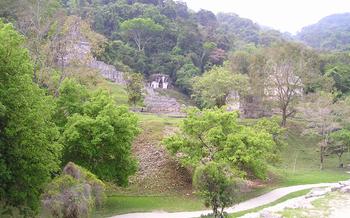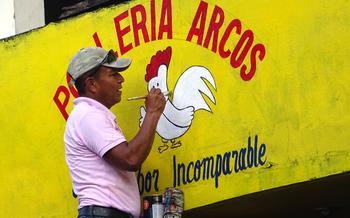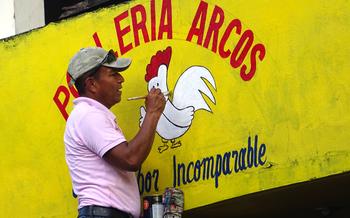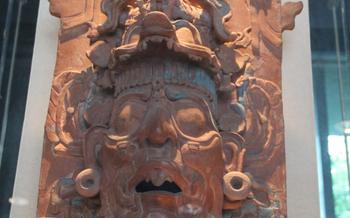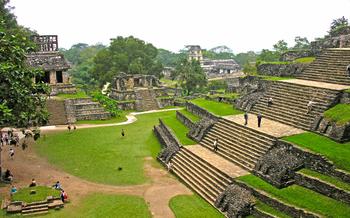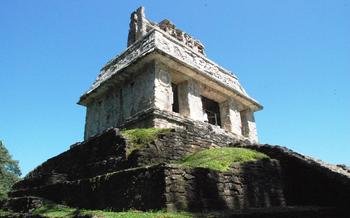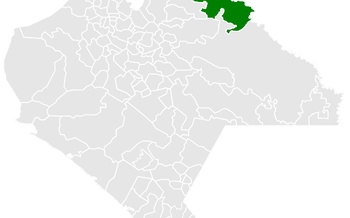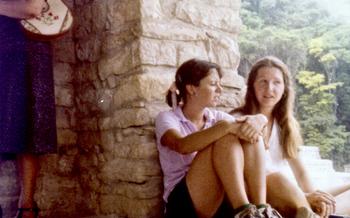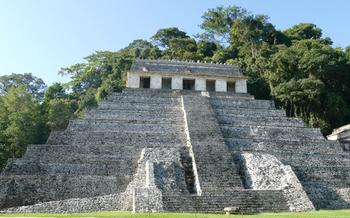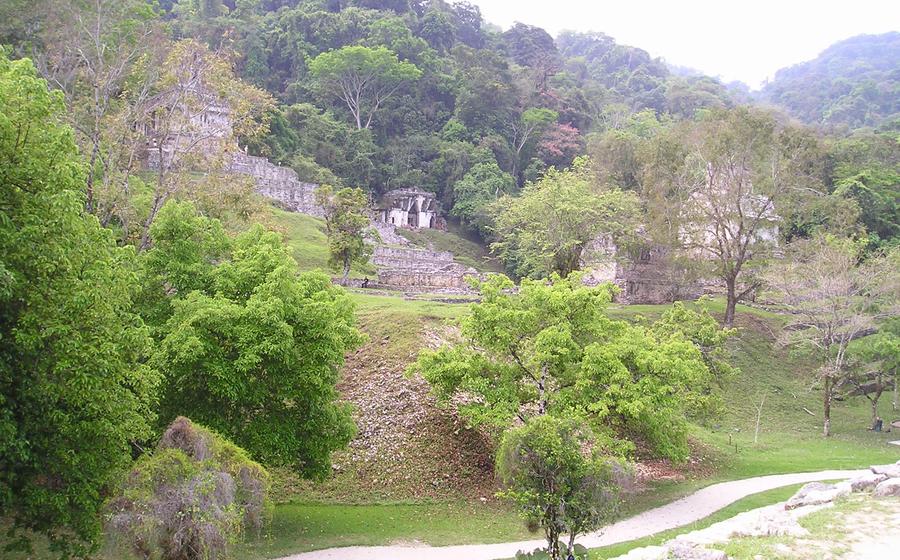
Group of the Cross
- Historical Significance
- Architectural Highlights
- The Temple of the Cross
- The Temple of the Sun
- Temple of the Foliated Cross
- Temple of the 12 Tablets
- Other Structures
- Surrounding Attractions
- Cultural Significance
- Restoration and Conservation
- Local Cuisine
- Accommodation
- Transportation
- Insider Tip: Unveiling the Secrets of the Group of the Cross
Historical Significance
Palenque, a Mayan city nestled in the lush jungles of Chiapas, Mexico, holds a profound historical significance. It flourished during the Classic period of Mayan civilization, reaching its peak between 600 and 800 AD. Among its many remarkable structures, the Group of the Cross stands as a testament to the city's grandeur and spiritual importance.
The Group of the Cross, named after the prominent cross-shaped temple within the complex, is a sacred precinct that played a crucial role in Mayan religious and political life. It served as a place of worship, where rulers and priests performed elaborate rituals and ceremonies to honor their gods and ancestors. The site's exceptional architecture, intricate carvings, and symbolic imagery provide valuable insights into the cultural and religious beliefs of the ancient Maya.
The Group of the Cross is not only a significant site for Palenque but also holds a prominent place in the broader context of Mayan history. It represents the culmination of centuries of cultural development and artistic expression, showcasing the ingenuity and creativity of the Maya. The site's well-preserved structures and artifacts offer a glimpse into the complex social, political, and religious systems that shaped this ancient civilization.
Architectural Highlights
The Group of the Cross stands out for its exceptional architectural features, showcasing the ingenuity and artistic prowess of the Maya. One of the most striking characteristics is the use of the corbelled arch, a technique that allows for the creation of wide, vaulted spaces without the use of true arches. This technique, commonly found in Mayan architecture, involves stacking stones in a way that each layer protrudes slightly over the one below, creating a gradual inward slope until the two sides meet at the top.
The Group of the Cross also displays a rich array of carvings and sculptures that adorn its structures. These intricate artworks depict various scenes from Mayan mythology and history, as well as images of rulers, deities, and other important figures. The Temple of the Sun, for instance, features a series of well-preserved stucco reliefs that depict the Maya creation myth, offering valuable insights into their beliefs and worldview.
Notable examples of Mayan architecture within the group include the aforementioned Temple of the Sun, renowned for its impressive size and intricate carvings, and the Temple of the Foliated Cross, adorned with unique and symbolic sculptures. These structures, along with the Temple of the Cross and the Temple of the 12 Tablets, showcase the diversity and complexity of Mayan architectural styles and techniques.
The Temple of the Cross
The Temple of the Cross is the most iconic structure within the Group of the Cross and one of the most significant Mayan temples in Palenque. Constructed during the reign of King Pakal the Great, it was dedicated to the Mayan goddess Ix Tz'akb'u Ajaw, also known as the Lady of the West. The temple is named after a large stone cross found within its sanctuary, a symbol that has been interpreted as a representation of the sacred ceiba tree, a symbol of life and fertility in Mayan culture.
The Temple of the Cross is a masterpiece of Mayan architecture, showcasing intricate carvings and bas-reliefs that depict various scenes from Mayan mythology and history. The temple's facade is adorned with a series of panels depicting the nine lords of the underworld, each associated with a different aspect of the afterlife. Inside the temple, visitors can admire the well-preserved stucco reliefs depicting scenes from the life of King Pakal the Great, including his birth, accession to the throne, and eventual transformation into a sacred tree.
The most remarkable feature of the Temple of the Cross is the discovery of the tomb of King Pakal the Great beneath the temple floor. The tomb was discovered in 1952 by Mexican archaeologist Alberto Ruz Lhuillier and contained the king's remains, along with a wealth of precious artifacts, including a jade death mask, a mosaic headdress, and various ceramic vessels. The discovery of the tomb provided invaluable insights into the burial practices and beliefs of the ancient Mayans.
The Temple of the Sun
The Temple of the Sun is another significant structure within the Group of the Cross, showcasing the architectural prowess of the ancient Mayans. Built during the reign of K'inich Janaab' Pakal, the temple is aligned with the summer solstice sunrise, demonstrating the Mayan's advanced astronomical knowledge. Its intricate carvings depict scenes related to the sun god, Kinich Ahau. The temple's interior features a central chamber with a corbelled arch, leading to a smaller sanctuary adorned with stucco reliefs and paintings. These depict scenes of rituals, sacrifices, and other important events, providing valuable insights into Mayan religious practices and beliefs. The Temple of the Sun stands as a testament to the Mayan's deep connection to celestial bodies and their sophisticated understanding of astronomy and timekeeping.
Temple of the Foliated Cross
The Temple of the Foliated Cross is a unique and striking structure within the Group of the Cross. It is believed to have been built around the 7th century AD and is named after the large foliated cross carved on its lintel. The temple is relatively small in size compared to other structures within the group but holds significant cultural and religious importance.
The temple's most distinctive feature is its intricate carvings, which depict a variety of mythological scenes and figures. The foliated cross itself is a symbol of the World Tree, which represents the connection between the underworld, the earthly realm, and the heavens. The temple's interior is decorated with additional carvings, including representations of the Maya Maize God and other deities.
The Temple of the Foliated Cross is believed to have been used for rituals and ceremonies related to the underworld and the concept of rebirth. This is supported by the presence of several burials within the temple, including that of a young woman who was found wearing a jade necklace and other valuable objects. The temple's association with the underworld is further reinforced by the fact that it is located at the western end of the Group of the Cross, the direction associated with death and the setting sun.
Temple of the 12 Tablets
The Temple of the 12 Tablets, also known as the Temple of the Inscriptions, stands as a testament to the rich history and cultural significance of Palenque. Constructed during the reign of Pacal the Great, this temple played a pivotal role in the city's religious and political life. Its name derives from the 12 stone tablets discovered within its walls, each intricately carved with hieroglyphs that provide valuable insights into Mayan history and mythology.
The temple's architecture showcases the refined craftsmanship and artistic prowess of the Maya. Its imposing facade features a grand staircase flanked by intricate carvings and sculptures. The interior chambers are adorned with well-preserved murals depicting scenes from Mayan mythology and royal life. The most notable feature of the temple, however, is the elaborately carved tablets. These tablets recount the lineage and accomplishments of Pacal the Great, providing a glimpse into the life and reign of one of Palenque's most renowned rulers.
The Temple of the 12 Tablets holds immense historical and cultural value. It serves as a window into the complex belief systems and political structures of the ancient Maya. The tablets, in particular, have been instrumental in deciphering Mayan hieroglyphics and shedding light on the intricate social and political dynamics of the Mayan civilization.
Other Structures
Beyond the three main temples, the Group of the Cross encompasses several other notable structures that offer a glimpse into the daily life and cultural practices of the ancient Maya. The Palace, once the residence of Palenque's rulers, is a sprawling complex with intricate carvings and a maze-like layout, reflecting the power and wealth of the Maya elite. The ball court, with its sloped sides and stone markers, was used for a ritual game that held both religious and political significance. The aqueduct, a marvel of engineering, brought water from a distant spring to the city center, demonstrating the Maya's advanced understanding of hydraulics. These structures, though less imposing than the temples, add depth and context to our understanding of Palenque's urban landscape.
Surrounding Attractions
Beyond the captivating ruins of the Group of the Cross, Palenque offers a wealth of natural and cultural attractions that beckon exploration. Immerse yourself in the verdant embrace of the Palenque National Park, a biosphere reserve teeming with diverse flora and fauna. Hike through lush rainforests, encounter playful monkeys swinging through the trees, and spot exotic birds flitting among the vibrant foliage.
Marvel at the mesmerizing beauty of the Agua Azul Waterfalls, a cascade of turquoise waters tumbling over limestone cliffs into natural pools below. Take a refreshing dip in the cool waters, bask in the sun's warmth, and let the gentle sound of the falls lull you into tranquility.
Discover the hidden gem of the Misol-Ha Waterfall, nestled amidst a lush jungle setting. Admire the cascading waters plunging into a crystal-clear pool, surrounded by lush vegetation and the haunting cries of tropical birds. Take a refreshing swim, relax on the nearby rocks, and soak in the serenity of this natural paradise.
Planning a comprehensive itinerary for the Palenque region is essential to make the most of your visit. Allocate ample time to explore the Group of the Cross, but leave room for day trips to these surrounding attractions. Consider booking guided tours or renting a car for the ultimate flexibility and freedom to customize your exploration.
Cultural Significance
The Group of the Cross stands as a testament to the richness and complexity of Mayan culture, embodying their profound connection to the divine and their intricate belief system. This sacred complex provides a glimpse into the spiritual world of the ancient Maya, showcasing their sophisticated understanding of astronomy, mathematics, and architecture. The structures within the group are adorned with intricate carvings and sculptures that depict mythological scenes, historical events, and the ruling dynasty, offering insights into their social and political organization. By exploring the Group of the Cross, visitors can gain a deeper appreciation for the cultural heritage of the Maya and their enduring impact on the region's identity.
Restoration and Conservation
The Group of the Cross has undergone significant restoration and conservation efforts to preserve its architectural wonders for future generations. Since the 19th century, explorers and archaeologists have been working to document and protect the site. In the 1950s, the Mexican government established the National Institute of Anthropology and History (INAH) to oversee the restoration and conservation of archaeological sites throughout the country, including Palenque.
INAH has conducted extensive excavations, stabilization projects, and restoration work at the Group of the Cross. They have carefully removed vegetation, repaired damaged structures, and consolidated crumbling walls to ensure the longevity of these ancient masterpieces. The restoration process involves using traditional techniques and materials to maintain the authenticity of the site.
Despite these efforts, the Group of the Cross faces various challenges, including the effects of time, weather, and tourism. The humid climate and heavy rainfall in the region can cause erosion and damage to the structures. Additionally, the increase in tourism has led to increased foot traffic, which can put stress on the delicate ruins.
To address these challenges, INAH has implemented sustainable tourism practices to minimize the impact on the site. They have established designated trails, limited the number of visitors, and educated tourists about the importance of respecting and preserving the ancient ruins.
The conservation and restoration of the Group of the Cross are crucial for preserving Mexico's cultural heritage and ensuring that future generations can continue to appreciate the grandeur and beauty of this ancient Mayan city.
Local Cuisine
Palenque's cuisine is a blend of Mayan culinary traditions with influences from the surrounding region. Traditional dishes often feature fresh local ingredients, such as corn, beans, and squash, combined with spices and herbs to create flavorful and aromatic dishes. Must-try dishes include Pejelagarto Asado, a grilled fish dish, and Tamales Chiapanecos, delicious corn-based tamales filled with various fillings.
Local markets are a great place to sample the region's authentic flavors. Here, you can find fresh produce, traditional spices, and handmade tortillas. For a truly immersive experience, visit one of the local restaurants that serve traditional Mayan dishes, often cooked using ancient techniques passed down through generations.
Supporting the local economy is vital, and trying the local specialties is a great way to do so. It allows you to directly support local farmers, vendors, and restaurateurs while enjoying a taste of Palenque's rich culinary heritage.
Accommodation
When planning your visit to Palenque, you'll find a diverse range of accommodation options to suit every budget and preference. Whether you're seeking a budget-friendly hostel, a comfortable mid-range hotel, or a luxurious resort experience, Palenque has something to offer.
For those on a shoestring budget, there are several hostels that provide basic but clean and comfortable accommodations. These hostels often have a vibrant atmosphere, allowing you to meet fellow travelers and share stories of your adventures. Mid-range hotels offer a step up in comfort and amenities, with private rooms, air conditioning, and sometimes even swimming pools.
If you're looking for a truly special experience, consider splurging on a stay at one of Palenque's luxury resorts. These resorts offer top-notch amenities, such as private balconies with stunning views of the jungle, gourmet restaurants, and indulgent spa treatments.
To find the best accommodation for your needs, it's a good idea to book your stay in advance, especially if you're visiting during the peak tourist season. Online booking platforms and travel agents can help you compare prices and availability, or you can contact the hotels directly.
No matter where you choose to stay, you'll find that Palenque's hotels and resorts are committed to providing a warm and welcoming experience. The friendly staff is always happy to assist you with any questions or requests, ensuring that your stay in Palenque is as enjoyable and memorable as possible.
Transportation
Reaching Palenque and the Group of the Cross is relatively straightforward, offering various transportation options to suit your preferences and budget.
Renting a Car:
For the ultimate flexibility and freedom, consider renting a car. The drive from popular tourist hubs like Cancun or Merida is scenic, allowing you to explore the region at your own pace. However, keep in mind that driving in Mexico can be challenging, especially if you're unfamiliar with the roads and local driving habits.
Public Transportation:
If you prefer a more budget-friendly option, public transportation is readily available. Buses connect Palenque to major cities and towns in the region, including San Cristobal de las Casas, Villahermosa, and Campeche. Once in Palenque, local buses or taxis can take you to the Group of the Cross.
Joining a Tour:
For a hassle-free experience, consider joining a guided tour. Many tour operators offer day trips or multi-day itineraries that include visits to Palenque and other nearby attractions. This option is ideal if you want to learn more about the history and significance of the site from knowledgeable guides.
Each transportation method has its pros and cons. Renting a car offers the most flexibility but requires more planning and caution. Public transportation is economical but can be time-consuming and less comfortable. Guided tours provide convenience and expertise but may limit your freedom to explore at your own pace. Ultimately, the choice depends on your budget, travel style, and preferences.
Insider Tip: Unveiling the Secrets of the Group of the Cross
Beyond the iconic structures that draw the crowds, the Group of the Cross holds secret spots and hidden gems waiting to be discovered by curious travelers. One such gem is the Temple of the Inscriptions, tucked away in the dense jungle vegetation. This temple is notable for its well-preserved hieroglyphic inscriptions that provide valuable insights into the history and culture of Palenque.
For photography enthusiasts, the best time to visit the Group of the Cross is during the early morning or late afternoon when the golden light casts a magical glow on the ancient structures. Tripod and wide-angle lenses are recommended to capture the grandeur of the site.
To experience the Group of the Cross like a local, consider exploring the surrounding countryside. Take a refreshing dip in the nearby Otulum Waterfall, hike through the lush jungle trails, or embark on a boat trip down the Palenque River. These activities offer a unique perspective of the region's natural beauty and cultural heritage.

